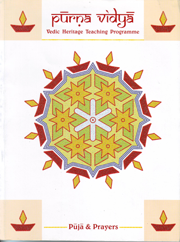
The programme includes a book called ‘Puja and prayers’ which contains the puja and prayers to be learned by the teacher with the help of the accompanying audio tapes. The prayers are to be taught from the first year onwards, while the puja is to be taught from the third year to twelth year. The audio cassettes contain chants of the prayers included in parts one to twelve. The mantras are recited to help the teacher learn the chants of the prayers included in Parts One to Twelve before teaching the students.
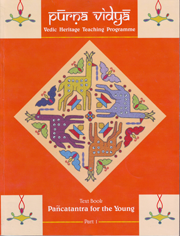
Part one comprises of selections from Panchatantra. These short stories having animals as the main characters are unique in their ability to draw the attention of the young children and educate them in right and wrong. They learn that animals also have to be related to, not as objects of enjoyment or consumption, but as much right to belong to it, as we do.With the storytelling, discussion of the lesson derived from it, and the activity, the twenty stories in this part can be covered over the course of the academic year. Eight slokas are also taught in the first year.

Part two comprises of selections of stories from the Puranas. They are stories of the Lord in His manifold divine expressions such as Ganesha, Shiva, Hanuman, Parvati and celestials such as sage Narada. Several stories are divinities portrayed in form of children. Youngsters can easily identify with these characters. The simple stories are easy to remember and carry profound messages. By listening to them young children develop a reverential attitude for our religious traditions and learn universal values.Five more slokas (in addition to the eight in Part One) are introduced in Part Two as a part of sixteen-step puja. They may be taught to children and recited at the beginning of each session.
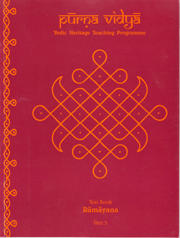
The topic covered in Part Three is Ramayana. Ramayana depicts the life stories of Sri Rama and others in Ramayana, and become a means to educate the students on dharma-adharma. This part also introduces the sixteen-step puja. It is a basic format of worship followed by people belonging to Vedic tradition and is also ancient and profound.
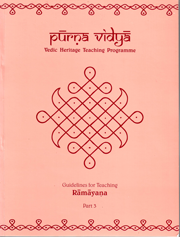
The topic covered in Part Three is Ramayana. Ramayana depicts the life stories of Sri Rama and others in Ramayana, and become a means to educate the students on dharma-adharma. This part also introduces the sixteen-step puja. It is a basic format of worship followed by people belonging to Vedic tradition and is also ancient and profound.
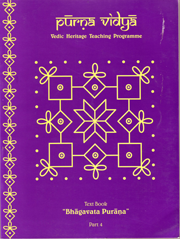
Part Four is made up of stories of ten avatars of Lord Visnu and other selected stories. All these stories highlight the necessity and outcome of living a life of dharma. Such understanding strengthens one’s faith in living a life with values.While science provides us with the knowledge of how things work in the world and its application makes one’s life more comfortable, mythology serves the purpose of giving meaning to one’s life. Thus both science and mythology enrich one’s life in different ways. One gives physical comforts, while the other, spiritual upliftment.
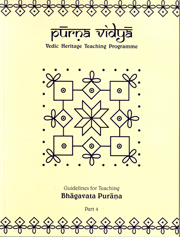
Part Four is made up of stories of ten avatars of Lord Visnu and other selected stories. All these stories highlight the necessity and outcome of living a life of dharma. Such understanding strengthens one’s faith in living a life with values.While science provides us with the knowledge of how things work in the world and its application makes one’s life more comfortable, mythology serves the purpose of giving meaning to one’s life. Thus both science and mythology enrich one’s life in different ways. One gives physical comforts, while the other, spiritual upliftment.
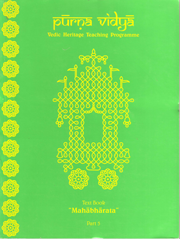
The topic covered in Part Five is Mahabharata which depicts the lives of kings and the people of their times. Thus the lives of Sri Krsna, the Pandavas and others in Mahabharata become a means to educate the students on dharma-adharma and help them distinguish between the two. If they are taught to think freely and properly when young, this task becomes easier for them as they grow older.
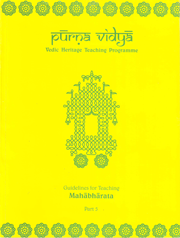
The topic covered in Part Five is Mahabharata which depicts the lives of kings and the people of their times. Thus the lives of Sri Krsna, the Pandavas and others in Mahabharata become a means to educate the students on dharma-adharma and help them distinguish between the two. If they are taught to think freely and properly when young, this task becomes easier for them as they grow older.
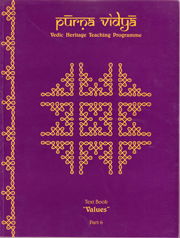
Part Six deals with the subject of Values. While it is easy for an adult to tell a child what to do and what not to do, it is not easy to explain the reasons of do’s and don'ts.To live an ethical life in conformity with a universal moral order freely and without a sense of compulsion is the hallmark of a mature individual. Different values and situations that present themselves in day-to-day life are carefully analyzed as the student is taught how to think correctly and interpret values. Teachers will find these topics stimulating, at times challenging and quite enjoyable to teach.
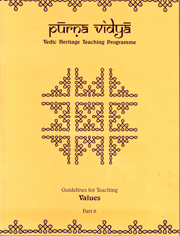
Part Six deals with the subject of Values. While it is easy for an adult to tell a child what to do and what not to do, it is not easy to explain the reasons of do’s and don'ts.To live an ethical life in conformity with a universal moral order freely and without a sense of compulsion is the hallmark of a mature individual. Different values and situations that present themselves in day-to-day life are carefully analyzed as the student is taught how to think correctly and interpret values. Teachers will find these topics stimulating, at times challenging and quite enjoyable to teach.
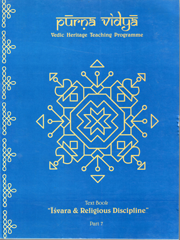
The subject matter of Part Seven is Isvara and Religious Disciplines. This can be an intimidating subject to teach students. In the Vedic culture, Isvara is not looked upon as a matter for belief, but as a subject matter to be understood and contemplated upon. Teachers will find this profound subject dealt with in a simple language that they can easily understand and communicate to the students.Cultural disciplines such as vows, pilgrimages and so on, which are such an inherent aspect of our traditions will find a new meaning and be well understood.

The subject matter of Part Seven is Isvara and Religious Disciplines. This can be an intimidating subject to teach students. In the Vedic culture, Isvara is not looked upon as a matter for belief, but as a subject matter to be understood and contemplated upon. Teachers will find this profound subject dealt with in a simple language that they can easily understand and communicate to the students.Cultural disciplines such as vows, pilgrimages and so on, which are such an inherent aspect of our traditions will find a new meaning and be well understood.
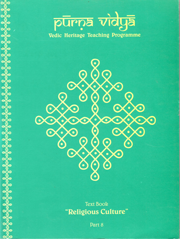
Part Eight deals with the religious culture of India. Throughout history, our land and its people have been a source of inspiration to people all over the world. This is because our way of life is highly spiritual and guided by humanistic principles that are truly universal.Teachers will be able to help student discover the deep spiritual insights that underlie our cultural forms whether it be in the manner of our attire, food habits, literature of fine arts. Students can there by discover the richness of their culture and develop pride in their heritage.

Part Eight deals with the religious culture of India. Throughout history, our land and its people have been a source of inspiration to people all over the world. This is because our way of life is highly spiritual and guided by humanistic principles that are truly universal.Teachers will be able to help student discover the deep spiritual insights that underlie our cultural forms whether it be in the manner of our attire, food habits, literature of fine arts. Students can there by discover the richness of their culture and develop pride in their heritage.
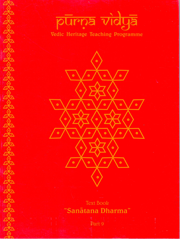
This part covers the significant topic of Samskaras (sacraments) and Sanathana Dharma. Their positive psychological impact in a human mind and development is also explained. Certain unique aspects of Vedic dharma such as karma, avatara, varnas and other topics are discussed. The first prayer in this part is a contemplation which is recited in the morning. This prayer is followed by Vedic mantras, called Shanti-mantras, which invoke the blessings of the Lord.

This part covers the significant topic of Samskaras (sacraments) and Sanathana Dharma. Their positive psychological impact in a human mind and development is also explained. Certain unique aspects of Vedic dharma such as karma, avatara, varnas and other topics are discussed. The first prayer in this part is a contemplation which is recited in the morning. This prayer is followed by Vedic mantras, called Shanti-mantras, which invoke the blessings of the Lord.
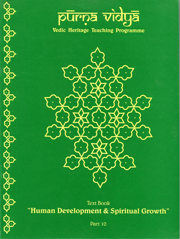
Part Ten addresses the subject matter concerned with human growth. This section gives a broad overview of human development and deals with many of the important issues confronted by teenagers. The topics are written to generate open, candid and meaningful discussions between adults and teenagers. This brings about a deeper understanding of the issues, thereby allowing a person to make informed choices with respect to his or her actions.

Part Ten addresses the subject matter concerned with human growth. This section gives a broad overview of human development and deals with many of the important issues confronted by teenagers. The topics are written to generate open, candid and meaningful discussions between adults and teenagers. This brings about a deeper understanding of the issues, thereby allowing a person to make informed choices with respect to his or her actions.
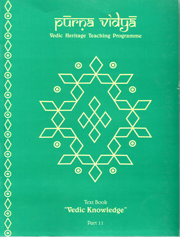
Part Eleven deals with Vedic thought and literature and some salient features of Sanathana Dharma. Various disciplines of knowledge, as diverse as architecture, sculpture, warfare, medicine, poetry and music were dealt with in astounding detail by the people of the Vedic society. The topics covered in this section are by no means exhaustive; they provide only a survey of certain significant subjects dealt within the vast Vedic literature.
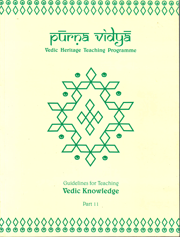
Part eleven deals with Vedic thought and literature and few salient features of Hinduism.Various disciplines of knowledge, as diverse as architecture, sculpture, warfare, medicine, poetry and music were all dealt with astounding detail by people of vedic society.These topics provide survey of certain significant subjects dealt with in the vast Vedic Literature.
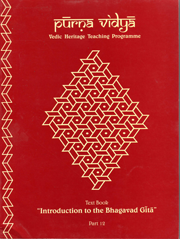
Part Twelve contains an introduction to the Bhagavad Gita and a comprehensive analysis of chapter two, which encapsulates the subject matter contained in the remaining sixteen chapters of Gita.This section is meant to introduce teenagers to the profound subject matter of the Bhagavad Gita. With this introduction to the Gita, the teenager will be well equipped to further pursue his study of the scripture, even in his adult years. The process of education is something that never comes to an end. One continues to mature throughout one’s life, making one’s life richer and fulfilling.
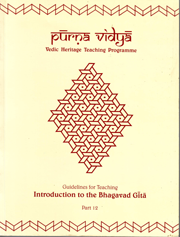
Part Twelve contains an introduction to the Bhagavad Gita and a comprehensive analysis of chapter two, which encapsulates the subject matter contained in the remaining sixteen chapters of Gita.This section is meant to introduce teenagers to the profound subject matter of the Bhagavad Gita. With this introduction to the Gita, the teenager will be well equipped to further pursue his study of the scripture, even in his adult years. The process of education is something that never comes to an end. One continues to mature throughout one’s life, making one’s life richer and fulfilling.
Any parent, teacher or a volunteer
who is interested to learn the vedic heritage of India
and share the teachings with others.
Sphurthi Consulting Services Private Limited
Molapalayam, Coimbatore - 641101
Tamilnadu, India
Publications Division
Phone:+91-8610026906,
+91-78458-88904
Whatsapp: +91-78458-88905
Email: purnavidyachennai@gmail.com
contact@sphurthiconsultingservices.in
Leadership and Consulting Programs
Phone:+91-9731710841,
+91-9840943473
Email: contact@sphurthiconsultingservices.in
Copyright @ Sphurthi Consulting Services Private Limited 2024
| Terms and Conditions | Privacy Policy